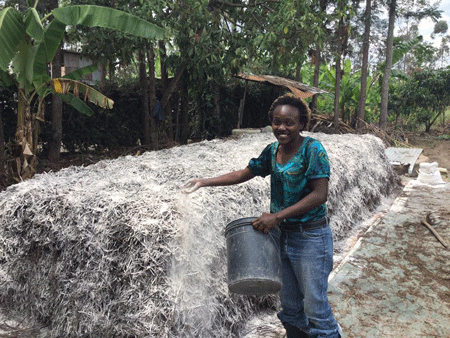
Mushroom farming changing fortune of a young lady in Murang’a
By Steven Mulanda
It is now clear that in this times and age, farming requires more young people not only to secure Africa’s future food security but also to create a source of livelihood to an increasingly young population that is faced with bleak opportunities of employment.
It is evident that quite a sizeable number of young people have embraced agriculture as an agribusiness. One such person is Catherine Wanjiku Njuguna a 24 year old young lady and a Degree holder in Horticulture from Jomo Kenyatta University of Agriculture and Technology (JKUAT), who has ventured into Button Mushroom farming.
Mushroom farming in Kenya has gained popularity as more health conscious generation embraces consuming this diet. Mushroom delicacy is rich in proteins, fiber, potassium, vitamin C, Selenium and many more that helps in boosting body immune system.
There are four popular mushroom species currently grown; Button Agaricus bisporus, Oyster Pleurotus spp, Shiitake Lentinula edodes and Reishi Ganoderma lucidun. Out of the four, Oyster variety is the easiest to cultivate; growing in a wide range of substrates and temperatures, and thus referred to as ‘mushrooms for all seasons’.
However, Button mushroom has the highest demand, with Kenya importing up to 80,000 tonnes to satisfy its tourist industry. This is due to its complicated growing process that makes many farmers shun it. But with the knowhow, this variety pays handsomely. A 250gms sachet retails at Ksh200 in the open market hitting to lows of at least Ksh150.
Before venturing into button farming, she did a market survey and discovered that the variety has high returns and also there are few farmers in the country who are cultivating it hence its the high demand.
“It has been a tough and exciting farming journey. Every day to me is a learning process and perfecting my craft so that I would be able to produce more volumes,” says the soft-spoken, Catherine. She is the founder and C.E.O of Seta Farm in Mutuini village, Murang’a County. Seta means mushrooms in Spanish.
Her interest in mushroom farming was conceived when at JKUAT where the institution runs an elaborate mushroom growing resource centre that trains students and farmers on mushroom farming. JKUAT also sells mushroom spawns to prospective farmers. “At campus, I used to pass by the mushroom centre to get a glimpse on how mushrooms are grown. I developed interest and I also did a research online and found out that the venture doesn’t require much water hence I would minimize my cost of production,” Catherine said.
After completing her studies at JKUAT, she secured a formal employment to secure a startup capital that enabled her kick start her mushroom business. While working, she enrolled for a short course at Miramar International College at Kikuyu where Mushroom farming was being taught. This spiked her more and she quit employment to venture fully into farming. Besides growing Mushrooms, Catherine trains self help groups and farmers at a fee. Gekeno Women Group is one of her exemplary group she trains on mushroom cultivation from the first step to harvest.
“I have two mushroom growing houses and I produce about 800kilograms that I sell mainly in Nairobi and I can assure you the demand is high,” she said.
The most appropriate and cost-effective structures for mushroom production is grass-thatched mud house. An 8 by 10 feet structure is enough to grow mushrooms. Catherine started with a 5 by 8 ft. The house should be rodent-proof to keep off rats. It also has to be initially dark before introducing some light at a later stage. Mushrooms, which have 80 to 90 per cent water content, need a humid environment to thrive. To achieve this, she sprinkles water in the room throughout the day.
“In growing mushrooms, first a farmer needs to have the substrates of composting which I call hay; this is the wheat straw or any other substrate that is made up of agricultural waste. Almost anything that is cultivated on land is a potential substrate for mushroom cultivation. You can use wheat straw, rice, banana and coconut waste, maize cobs, sawdust and even water hyacinth. Anything from the legume family, such as bean waste is also great because of the nitrogen content,” Catherine explained.
According to National Farmers Information Service (NAFIS), Kenya produces 500 tonnes of mushrooms per year of which 476 tons are button mushroom against an annual demand of 1200 tonnes. This means there is a high demand of the crop. A kilogram of mushroom is priced at between Sh400 and Sh600.
Research done by JKUAT shows that, there is a huge shortage of mushroom supply, locally. The main reason for this is that there was no institution that was producing certified mushroom seeds (Spawn) before JKUAT started. At the same time, consumers were not aware of the health benefits derived from eating mushrooms. Mushrooms can substitute red meat because they have no cholesterol
For more information
Contact Shiku
0724175408

